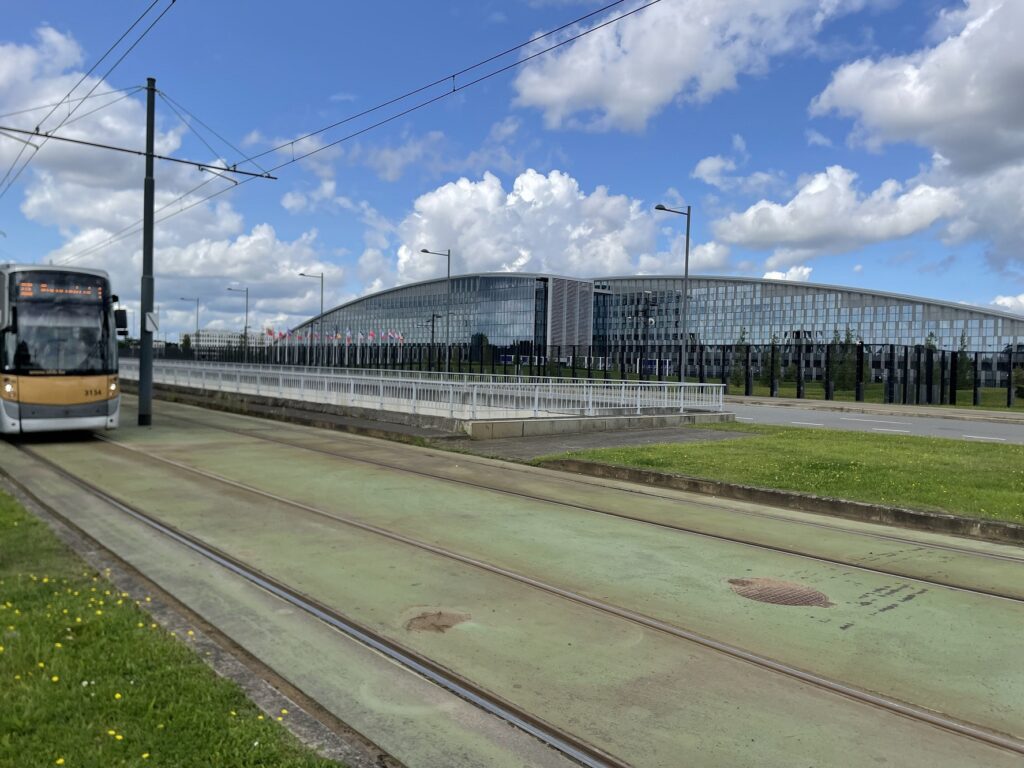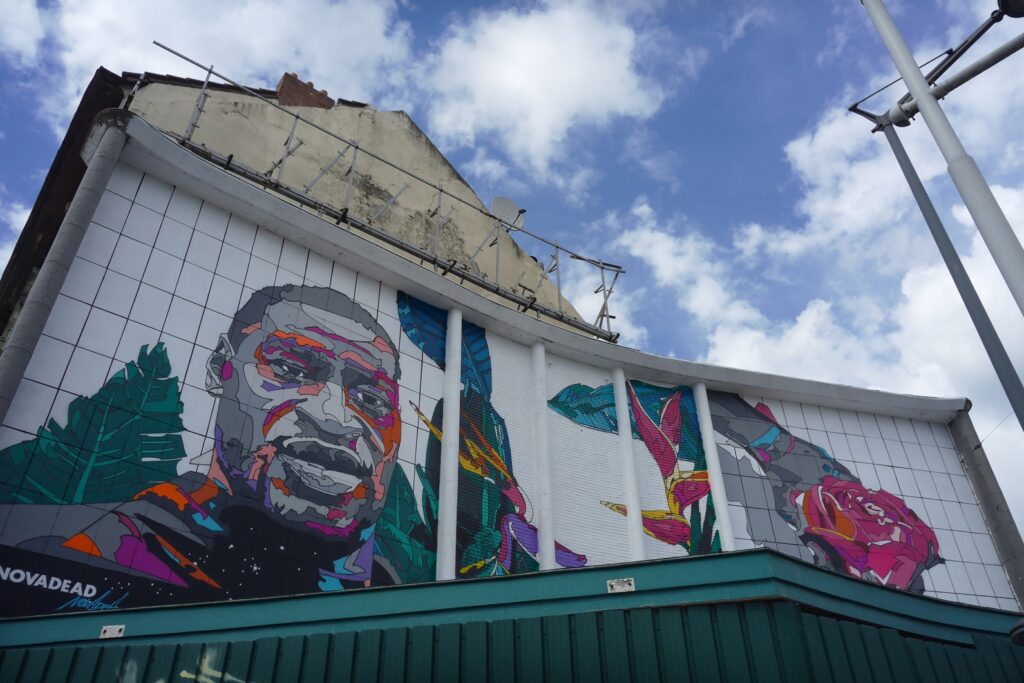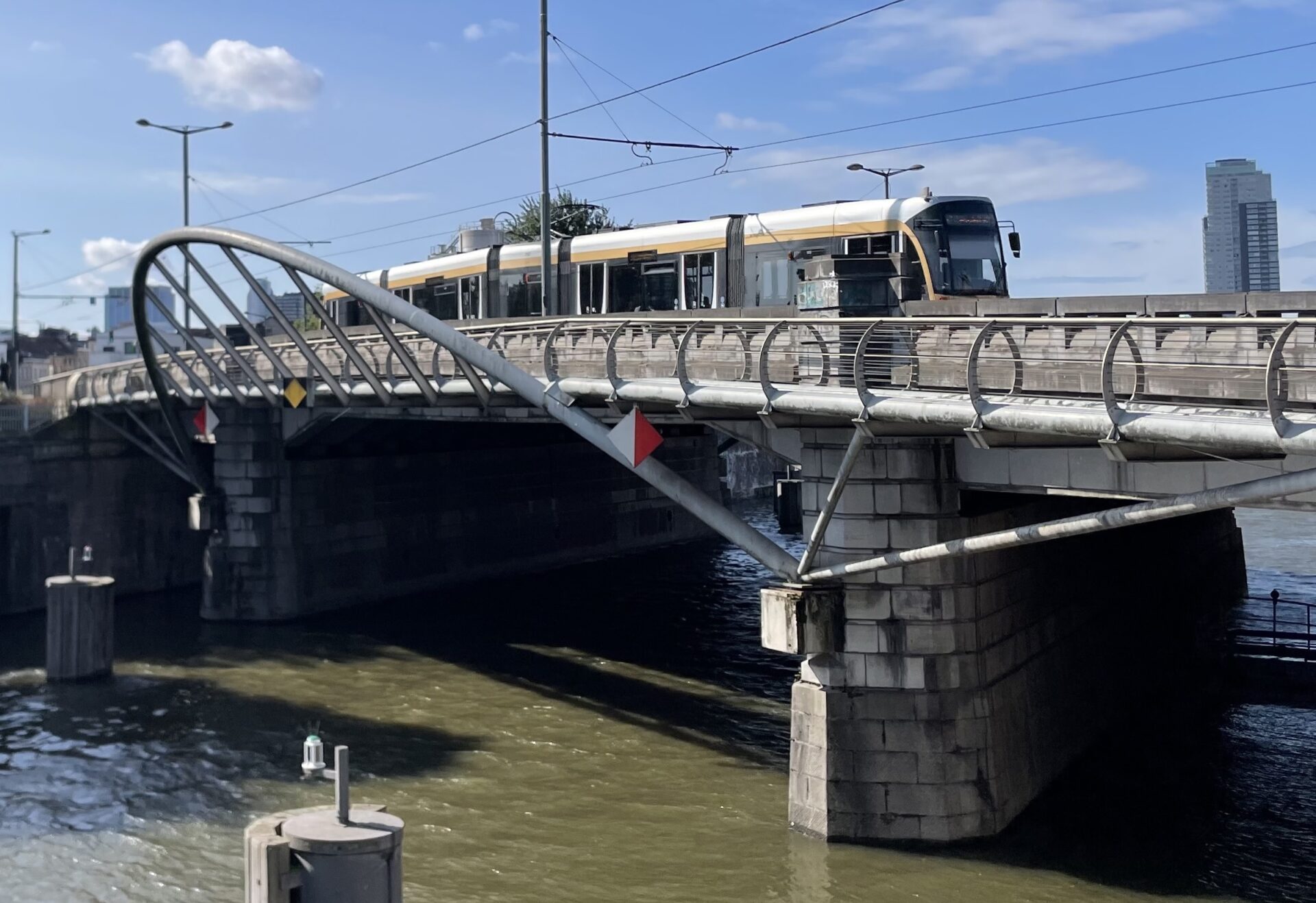The 62 tram starts its gritty peregrinations flanked by both the new and the old NATO headquarters.
The new one, on your right (Bourget stop) going into town, is handsome, even iconic. The sparsely landscaped lawns and car parks which surround it (ignoring for a moment the perimeter fence) afford an untrammelled view of its elegant curves. From the side it bears a certain resemblance to an artificial ski slope and from above to the teeth of a zipper. This aerial view seeks to symbolise interlocking fingers: a strong alliance
NATO started life in London in 1949, then opened two headquarters in Paris in 1952: one dubbed “temporary” and the other “permanent”. Each lasted seven years until French President Charles De Gaulle unceremoniously expelled the alliance in 1959. NATO moved for the fourth time to the unlovely building one can observe on the left heading into town on the 62 (Rue du Fusee/Raketstraat).
Built in a breakneck 29 weeks, it was also seen as temporary. However, it was only vacated in 2018 and handed back to the Belgian government. Now it houses high-security terrorist trials.
NATO’s new building, its fifth iteration, is built upon part of the old Haren Airport. Founded by German occupiers in 1914 during the First World War and called Flugplatz Brüssel, it kept the Zeppelin LZ38 in a specially built hangar. The hangar was destroyed in an attack in 1915, but the Germans continued to use Haren as a general-purpose military airport until their retreat in 1918.

The terminus at NATO
The airport slowly acquired commercial flights after the war, including the trailblazer to Leopoldville by the-then national airline, Sabena. In 1925, a Handley Paige W8f named the Marie-Jose took a leisurely 50 days to get there with a total of 75 hours in the air. It carried mail and a handful of passengers.
Once things settled down the travel time was reduced to a mere eight days. Harem itself was deemed advanced enough to merit a visit from Charles Lindbergh right after his historic New York-Paris flight that same year.
During the Second World War, the Germans again militarised it and assembled fighter planes there during their second occupation of Belgium.
I know this because I talked to a Belgian long ago who had worked on this very assembly line in his youth. He recounted how he and his pals would partially file through crankshafts, put sand in cylinders, falsify fuel gauges and otherwise sabotages the planes they were supposed to be building for the enemy. Their hope was that it would take time to do damage, and therefore could not be traced back to them.
Since he stood before me, decades later, hale and hearty, he clearly succeeded. I remember marvelling that this quiet chap, now a humble clerk, who risked torture and the firing squad for his country. His last words on the matter, sighed with due Belgian modesty, were “Il vaut mieux ne pas parler de ces choses!” We should not speak of such things.
Un-Belgian boulevard
Leopold III into town. The fact that this road is still named after the disgraced king who surrendered to the Germans in Second World War without consulting his ministers or allies is an anomaly.
One expatriate Dutchman, describing the difference between his native and adopted land, said “In the Netherlands everything is in straight lines. Here everything is twisty!” When asked whether he meant twisty architecture and roads or twisty thinking he paused and said “Both!”
Related News
- Tram 92, from Schaerbeek Station to Fort Jaco
- Tram 81, from Montgomery to Marius Renard
- Trams 44 and 39, from Montgomery to Tervuren and Ban Eik
- Tram 8, from Roodebeek to Louise
Which brings one to a second anomaly: the road here is straight and the architecture of a piece. There is something deeply un-Belgian about the sameness of the middle-class houses on either side of the boulevard. Belgian planning may put size limits on buildings, but it tends to give the builder a lot of freedom of expression and not concern itself too much with the vernacular. Boulevard Leopold III, not so much. In short, it looks Dutch.
A very elderly gentleman told me many years ago that he remembered when the area was all pastureland and even had its own breed of black sheep. For the life of me, I can find no trace of this online, so I must take him at his word.
First-class mess
The 62 sagely skirts Place Meiser/Meiserplein, getting as close to a hairpin bend as a tram allows, and then scoots off down Avenue Rogier/Rogierlaan towards the Gare du Nord/Nordstation.

Rounding Place de la Patrie
Sagely because Meiser is a first-class mess. An uneasy juxtaposition of crossroads and a roundabout, it attempts to process the confluence of traffic from six or seven different sources, two of which are themselves recipients of a steady flow of traffic from the Liege motorway and the airport. And if you’re a pedestrian going north to south, be prepared to walk round a vast circle designed for cars.

Place Meiser
Then there are at least three tram and bus stops scattered about, not to mention the De Lijn buses which must pass through it to get to Leuven and points east. Not for nothing is it dubbed Place Misère. There is hope, however! Plans are afoot to completely revamp it in 2025.
Down Rogier, flanked by trees and with tracks allowed to go green, the tram enters the Turkish quarter. The quarter only starts in earnest where the tram crosses Chaussée de Haecht/Haechtesteenweg (Lefranc). It narrows here, buses and trams vie for position in both directions, and delivery vans block access to the impatience of all. When the 62 tram meets its fellow bendy 66 going in the other direction, they creep past almost touching as each driver checks both mirrors continuously.
Fruit and vegetable shops display their wares proudly and clothes shops sell both traditional and western clothes. Turkish restaurants abound, offering home cooking at knockdown prices. Cafés are full of old men sitting at tables sipping searing mint tea. They wear the standard uniform of dark suit (white shirt buttoned to the neck, no tie and flat cap worn foursquare) while, as often as not, clicking prayer beads. They lean in close when they talk and frequently put their hands on each other’s shoulders.
One such Turkish man climbs onto my tram with a plastic bag. He sits down and then peers in at his purchases. He takes out a shiny purple aubergine. He caresses the ripe vegetable with his thumb and smiles beatifically to himself. There, I thought, sits a happy man.
The tram nears North Station. To the left is rue de Brabant/Brabantstraat (Place Liedtsplein). Here the vibe is definitely. Second-hand CDs of belly dancing music, sequinned dresses for Arab weddings, burnouses of every size and colour known to man, steaming frites (with enough falling from the cardboard container onto the tray to keep a trencherman going for a fortnight so generously are they piled up) beds, T-shirts emblazoned with the bedroom eyes of Egyptian pop stars, white goods, desserts of dentist-enriching sweetness, throws galore, leather sandals (which some Belgian-Moroccan men wear stoically throughout our damp and frigid winter), carpets (of course), cheap shoes and suits, sit-down couscous and tagine-cooked mutton, khobz bread (to be torn up and unceremoniously dunked in sauce), garden furniture, herbs and spices both common and rare, wet fish, halal meat…..the lot.
A word of advice if you go there: don’t be in a hurry. The crowd goes at its own pace and will not be jostled. And here’s another: don’t be afraid to engage with the market barkers. They are flirtatiously polite rather than aggressive. As one said to me when I declined his invitation to sit down and eat “Well, think of us next time you’re down this way!”
One road further west and a million miles away in vibe, hard against the North Station is the infamous Rue Aerschotstraat. A third word of advice: avoid. Trafficked girls stand in shop windows and drug dealers tout at street corners.
Two things are to be said in favour of this abomination. The police find squeezing all – or most of – this sleaze into one place makes it easier to keep an eye on things. And the sex-workers feel comparatively safe as they are in groups and at street level where help is at hand. It is a pity, though, that all of this is highly visible from the trains coming into North Station. Not the most salubrious introduction to our fair city. But perhaps there is consolation in the fact that the trains come in from the direction of the Netherlands, which have a simila, and better known system for the self-same reasons.

Our lady of Laeken church and the Atomium in the background
The 62 now plunges into Stygian gloom under railway lines which carry, at peak periods, 60 trains an hour; and then crosses the canal at the six-lane Jules de Trooz Bridge.
In front I now spot the elegant facade of Our Lady of Laeken church. Do not even think about, as I foolishly did, getting off at the nearest stop (Princesse Clémentine/Prinses Clementina) or you will be faced with a dark, malodorous tunnel under the intervening railway with steep steps at either end, disturbingly inhabited by shadowy figures. It’s by far better to get off at the canal (Marie Christine), pause to admire the rather expertly done mural of the unfortunate African American martyr George Floyd, and then walk up.

George Floyd mural at the Marie-Christine stop
The construction of Our Lady of Laeken, the last resting place of most of the Belgian royal family, came from from the desire of Louise-Marie, first queen of the Belgians, to be buried in Laeken.
In 1850 Joseph Poelaert, the architect who had designed the Brussels law courts, produced a simple design for the proposed church. Politicians and royals added bits here and there and, in the way of iconic monuments – think the Eiffel Tower, the Sydney Opera House, the Sagrada Familia in Barcelona – mission creep set in. Poelaert resigned “for health reasons”, architect succeeded architect, work lay fallow for long periods, and the building, although consecrated in 1872, was completed only in 1911.
To the south of the church is a small park dedicated to Belgian actress Annie Cordy who hailed from Laeken (the long tunnel from Place Rogier to the Koekelberg Basilica is also named after her). The park is untidy but has a rather jolly mural of her on an abandoned building and an elegant cafe nearby with an excellent view of the church.
Cordy conquered France with her astonishingly eclectic output. Films, musicals, plays, television series, concerts—she was indefatigable throughout her 50-year career. I saw her in a long-ago French film, “Sunk Without Trace” interpreting the role of a spinster on a lonely holidaywho is offered and afraid of accepting a surprising gesture oflove. I was astonished at how much pathos she wrung out of it. Back in the 50s she also had a major hit with the French version of “The Ballad of Davy Crockett.” No, really!
As I walked back down to the canal (that wretched tunnel!) I detoured along the palace wall and the bizarrely named ‘Palace beyond the Bridges’ Street. It was there that I spied a signpost to Rodin’s The Thinker. Could this be?
And so back up the hill and into the cemetery by the Café New Parvis. I turn right along the peripheral wall for 200 metres and there it is - one of the 20 or so famous castings that are now scattered from Recife to San Francisco. Well, who knew? Brussels’ very own The Thinker! The original is, of course, in the Rodin Museum in Paris.
If the 62 trundles through some of the grungier parts of Brussels, its final destination is an unexpected treat. It comes to rest in the verdant environs of Jette Cemetery. It is huge, with soaring, almost Sicilian family vaults and – somewhat to my surprise – a small sign denoting it as a Commonwealth War Grave.
A cheerful operative, driving a forklift truck with a couple of massive gravestones on it, pointed me to the British grave. “There’s only one,” he said. “Must be feeling a bit lonely.” I follow his directions and think to at least say hello. When I get there, I read that it was the last resting place of Sergeant Raymond van Wymers of the Royal Air Force Volunteer Reserve. Someone had had the sensitivity to bury him with his compatriots. Not so lonely after all.
My eye is drawn to the far side of the cemetery to a handsome red-brick church; one of many noble 19th century churches in Brussels that are worth a visit. St Peter’s in Place Mercierplein is no exception. For a start, two man-height stands of flowers flanked either side of the front doorway. Inside, volunteers were busy decorating lavishly for the upcoming floral festival, while artisans restored the organ at the back/corner/side.
I ask a woman when the church had been built built and she led me to the font, which was engraved ‘1597’.
1597? Red brick exterior? Surely not. And yet while the exterior is Victorian, the interior feels as though one has stepped back in time 400 years or more. The altar, the pillars, the confessional and, of course the font, all give off a look, and indeed a smell, of great venerability.
Then I’m back out into the elegantly unpretentious Cardinal Mercier Square - the focal point of Jette. If you stand in the middle, and have no objection to being run over, you can revolve 360 degrees and spot inter alia:
- the glorious facade of Jette’s largely forgotten railway station with the now abandoned moniker, Chemin de Fer de l’Etat/Staatsspoorwegen embossed in stone.
- joy, a café called Estaminet Schievelavabo.
Other eateries and drinkeries abound and one could, if so inclined, organise a perfectly decent pub crawl without losing sight of the station or the town hall.
But back to the estaminet on the square. Estaminet is a word for a humble pub where, crucially, smoking was permitted. In the second half of the 19th and the beginning of the 20th centuries, the term gained currency in northern France and Belgium. Posh cafes had banished smoking to attract female customers.
But Estaminets had no such inhibitions. They were unpretentious and friendly (and of course smoky) places with second-hand furniture, board games and simple food like waterzooi and stoofvlees. They were often housed informally in someone’s front room.
The word’s origins are in the old Walloon dialect for a byre. It was the kind of place where expatriated British Tommies drank in the First World War. I knew of only one in Brussels, just down from the Sablon near the railway bridge; but it disappeared several years ago. Hence my delight in discovering another!
For sure the 62 tram does not deign to visit the better-known tourist attractions of Brussels. But perhaps it is none the worse for that. As Bill Watterson has it, through the opinionated mouth of his obnoxious, six-year-old, hyper-energetic, superhero Calvin, “There’s treasure everywhere!”


